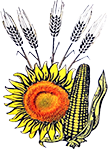The Influence of Sowing Date and Row Spacing on Grain Yield of Wheat
Diana Hirişcău, Rozalia Kadar, Adina Varadi, Ionuţ Racz
Staţiunea de Cercetare-Dezvoltare Agricolă Turda
Keywords: wheat, seed multiplication ratio, sowing date, row spacing, yield.
Abstract: Wheat production is influenced by environmental conditions, but it can be optimized by the sowing date. The nutrition space of the plants is ensured by the row spacing and by the distance between the plants in a row, an adequate spacing determining the optimization of the twinning capacity of the plants and a good development of the productivity elements. At ARDS Turda, the effect of these two technological elements (sowing date and row spacing) on wheat yield was studied in the period 2018-2020 on 9 varieties of wheat (Arieşan, Andrada, Codru - autumn wheat, Pădureni, Granny, Triso - spring wheat, Taisa, Ciprian, Lennox - facultative wheat). The research included 5 experiments corresponding to the 5 sowing dates (3 in autumn: I-III, 2 in spring: IV-V), the plants being sown in rows spaced at 12.5 cm (D1) and 25.0 cm (D2).
The aim was to establish an optimal sowing date and seed multiplication ratio for the studied varietes.
The best yield results were obtained in sowing dates II and IV, corresponding to the calendar periods October 30 - November 6 and March 1-15. By delaying sowing date, the productivity elements varied according to the variety. The number of fertile spikes/sqm decreased (except Taisa and Lennox in sowing date II), while the number of grains/spike increased. The weight of the grains/spike increased significantly only for the Arieșan, Andrada, Codru and Pădureni varieties. Pădureni is the only variety whose TKW has grown significantly by delaying sowing date.
To a wide row spacing, the number of fertile spikes/sqm and the yield decreased significantly, the number of grains/spike and the weight of grains/spike exceeded the control and the thousand kernel weight did not show statistically significant differences compared to the control (D1).
To a wide row spacing, in optimal conditions, the value of the seed multiplication ratio increases by up to 50%.
